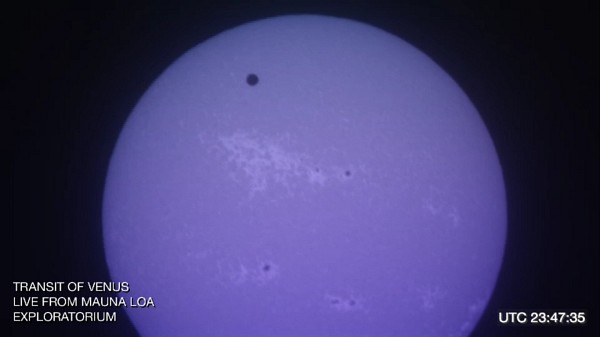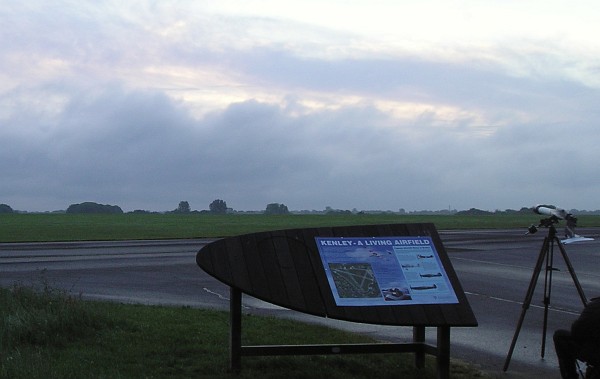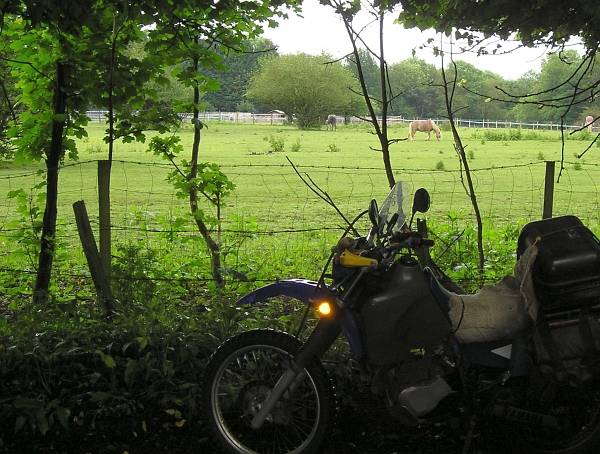The Transit Of Venus And Other Journeys
Yesterday was the Transit of Venus, earlier today was the Transit of East Surrey.
The Transit of East Surrey occurs every six months.
The Transit of Venus occurs every 110 years or so. In pairs, about 8 years apart.
It's when the planet Venus passes directly between the Earth and the sun, making it visible as a silhouette against the face of the sun.
To see one is quite something. You have to be born at the right time, give or take about 70 years. Neither of my parents lived at the time of a Transit, and my Grandchildren will never see one. With any luck my greatgrandchildren will be alive at the time of the next pair of Transits, but not necessarily.
So I made sure to see the previous one, in June 2004, which was easy as it was readily visible in Europe.

I was at the 60th anniversary of D-Day in Normandy and set up a simple white card and telescope clipped to my Honda Dominator to display the sun's image.

There's a tiny dark dot near the top edge of the sun's disc, which is the silhouette of the planet Venus passing between the Earth and the sun.
That Transit was quite satisfying to witness, seeing as they happen so infrequently.
Consequently, the past week has focussed attention on the possibility of seeing two of them in one lifetime.
But the timing of yesterday's Transit was a little less sociable than 8 years ago.
It would be in progress right at sunrise, at a quarter to five. Demanding clear skies on the north-eastern horizon first thing in the morning.
So the evening before yesterday I followed the weather forecast closely. And it looked pretty hopeless.
Never mind, everything is possible. The Transit commenced late that same evening, visible in other parts of the word, enabling me to watch live feeds on the internet from observatories in the southern US and Hawaii. And pretty good pictures they were:

Internet feed from Mauna Loa, Hawaii, early on in the Transit. Venus is travelling from left to right. Telescope fitted with red sun-filter. 11:50pm London time.

Wider view from Mauna Loa with blue filter, at 00:47 Wednesday morning. Venus is above a large area of surface activity.

Magnificent close-up at the same time, showing lots of activity on the sun's surface. Live internet feed from Prescott Observatory, Arizona, via the SLOOH Space Camera service.
A while after the above observations, the sun set over the US, and then Hawaii.
But by now, the sunrise at Kenley Airfield, up above Whyteleafe, was approaching.
I checked the weather outside. Well, it looked like it was clearing - maybe......
So I collected together tripod, binoculars, white card, sun-viewing glass filter and camera and set off up to the airfield a few minutes away.
A father and son were already there, looking at the moon through a large telescope. The sky was nice and clear in the west, but stuffed full of dark cloud on the eastern horizon.

A few more small groups arrived while the dense clouds to the east swirled around in the wind, growing a little brighter.


And amazingly, (well, we were amazed), after a little more waiting, the clouds parted enough for clear views of the sun for the final 20 minutes of the Transit.
Result!
We were able to watch the tiny dark silhouette of Venus reach the edge of the face of the sun, and then disappear from view on its continuing orbit around it.
On returning home, the final few minutes of the Transit were still being observed in Japan, live on the internet:

From Kobe, Japan, via SLOOH again. About 10 minutes to the finish. Half an hour after the end of the Transit at Kenley.
A pretty lucky thing, to see two Transits in a lifetime! And with the help of the internet, at different places around the Earth.
That was yesterday. Today was the Transit of East Surrey to reach the hospital of the same name. For a consultation and to pick up the results of last week's 6-monthly test.

Transiting East Surrey earlier today - there's lots of horse life here. More than on Venus I think.
Well, the results were ready, and show that the ongoing treatment is still keeping everything clear. Resulting in the next tests being booked in another 6 month's time.
Venus's next transit is in 2117.
There's also the last day in the present Mayan calendar to look forward to, 21st December 2012 if you're interested.
